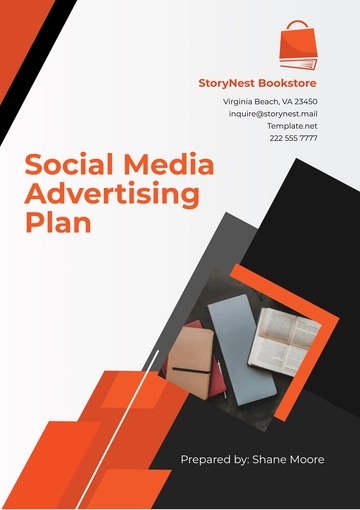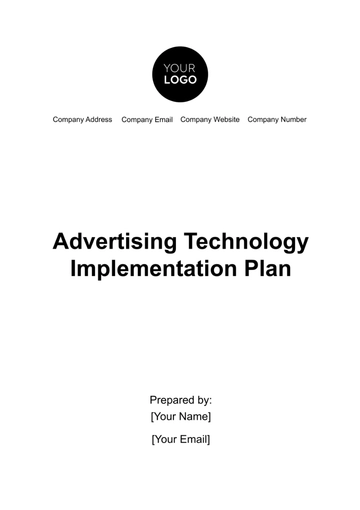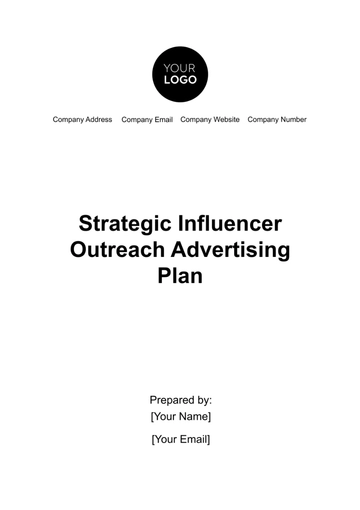Free Public Speaking Engagement Advertising Plan

Advertising Plan
1. Introduction
Welcome to the Public Speaking Engagement Advertising Plan for [Your Company Name]. This document serves as a comprehensive guide outlining our strategy to leverage public speaking opportunities as a powerful tool for advancing our advertising objectives.
a. Purpose and Scope:
This plan is crafted to harness the potential of public speaking engagements in amplifying our brand message, reaching targeted audiences, and establishing thought leadership within our industry. It outlines our approach, strategies, and tactics to effectively utilize speaking opportunities as a means of advertising and brand promotion.
b. Importance of Public Speaking in Advertising:
Public speaking engagements offer a dynamic platform to convey our brand's story, values, and offerings directly to audiences. Through compelling narratives, expertise-sharing, and engaging presentations, we aim to captivate, inspire, and influence our target demographic while reinforcing our brand's position in the market.
c. Alignment with Company Goals:
Our initiative to embrace public speaking as part of our advertising strategy aligns seamlessly with [Your Company Name]'s broader goals of enhancing brand visibility, fostering meaningful connections with our audience, and positioning ourselves as industry leaders.
d. Continuous Improvement:
This plan serves as a foundation for ongoing evaluation and refinement. By analyzing performance metrics, audience feedback, and industry trends, we commit to evolving our approach to maximize the impact of our public speaking engagements in achieving advertising goals.
2. Goals and Objectives
Our Public Speaking Engagement Advertising Plan is designed to achieve specific objectives aligned with our advertising strategy. The goals for leveraging public speaking engagements include:
a. Increase Brand Visibility:
Elevate brand awareness by securing speaking opportunities at prominent industry events, conferences, and forums, aiming to reach a wider audience and expand market presence.
b. Establish Thought Leadership:
Position [Your Company Name] as a thought leader in the industry by delivering insightful and engaging presentations that showcase our expertise, innovative ideas, and unique perspectives.
c. Generate Quality Leads:
Utilize speaking engagements to capture the interest of potential clients, partners, or stakeholders, aiming to generate leads and foster valuable connections within our target market.
d. Promote Product/Service Offerings:
Seamlessly integrate key product/service messaging into speaking engagements to highlight unique value propositions and solutions that address industry challenges.
d. Drive Engagement and Interaction:
Foster meaningful engagement with the audience during speaking engagements through interactive sessions, Q&A segments, and post-event discussions to create a lasting impact and encourage dialogue.
These goals and objectives provide a strategic framework to guide our efforts in leveraging public speaking opportunities as a significant component of our advertising strategy, aiming to enhance brand recognition, credibility, and audience engagement.
3. Target Audience Analysis
We target industry professionals, decision-makers, and stakeholders seeking innovative solutions. Our audience comprises tech enthusiasts, business leaders, and individuals keen on advancements within [Your Industry]. This segment values expertise, seeks thought leadership, and actively engages in forums, conferences, and industry events. We aim to engage this audience through insightful presentations, thought-provoking discussions, and actionable insights, catering to their interests, challenges, and aspirations. By understanding their demographics, interests, and pain points, we tailor our speaking engagements to resonate deeply with their needs, fostering meaningful connections and establishing [Your Company Name] as a trusted resource within the industry.
4. Speaker Selection Criteria
In choosing speakers for our engagements, [Your Company Name] prioritizes individuals renowned for their expertise, credibility, and alignment with our brand values. We seek speakers who exhibit exceptional knowledge, experience, and a track record of thought leadership within our industry. Emphasis is placed on selecting personalities capable of delivering compelling, audience-centric content, resonating with our target audience's interests and challenges. Additionally, we prioritize diversity, seeking speakers who represent diverse perspectives and backgrounds to enrich discussions and appeal to a broader audience. The selected speakers must align seamlessly with our company's values, ensuring their presentations contribute to reinforcing our brand identity and advertising objectives.
5. Event Selection and Strategy
[Your Company Name] meticulously identifies forums, conferences, and industry events that resonate with our target audience and align with our brand's objectives. We prioritize events with a strong attendee base matching our demographic and industry focus. Our strategy involves a comprehensive assessment of event themes, attendee profiles, and opportunities for speaker participation to ensure relevance and alignment with our advertising goals. We leverage speaking slots, sponsorships, and partnerships to maximize visibility and engagement. Emphasizing quality over quantity, we aim for strategic involvement in select events that best amplify our brand message, foster meaningful connections, and drive advertising objectives.
6. Content Development and Messaging
[Your Company Name] prioritizes delivering impactful, audience-centric messaging. We focus on developing insightful and relevant presentations that align with our advertising goals and resonate with our target audience's interests. Our content highlights innovative solutions, industry trends, and actionable insights, ensuring a compelling narrative that captures attention and adds value to our audience. Emphasis is placed on storytelling, engaging visuals, and concise delivery to effectively convey our brand's message. Additionally, messaging consistency across platforms reinforces our brand identity and advertising objectives, fostering lasting impressions and meaningful connections with our audience.
7. Promotion and Advertising Strategy
Our promotion and advertising strategy for speaking engagements involve a multi-faceted approach aimed at maximizing audience reach and engagement. We leverage various channels, including social media, email campaigns, press releases, and partnerships with event organizers or industry influencers. Tailored promotional content is disseminated across these channels to create anticipation and generate interest in our speaking engagements. Collaborations with relevant media outlets, industry blogs, and guest contributions further amplify our reach. By strategically positioning our speaking engagements through targeted advertising efforts, we aim to enhance visibility, attract our target audience, and drive engagement, ensuring a successful fusion of advertising and speaking opportunities.
8. Logistics and Support
Our plan ensures seamless logistics and comprehensive support for our speakers participating in engagements. We provide logistical support, including travel arrangements, accommodation, and technical requirements, ensuring speakers have the necessary resources for successful presentations. A dedicated support team offers assistance throughout the process, addressing any speaker needs or concerns promptly. Presentation materials, tech rehearsals, and on-site assistance are organized to ensure smooth execution. Additionally, clear communication channels and detailed guidelines guarantee alignment between our team and speakers, optimizing their performance and enhancing the overall success of our advertising-driven speaking engagements.
9. Metrics and Measurement
Our approach to measuring the success of our speaking engagements involves comprehensive metrics and key performance indicators (KPIs). We track audience reach, engagement levels, and lead generation metrics to assess the impact of each speaking opportunity. Additionally, sentiment analysis and audience feedback provide valuable insights into brand perception and effectiveness. KPIs include attendance rates, social media engagement, website traffic, and post-event inquiries. These metrics guide our evaluation process, allowing us to analyze the effectiveness of our advertising objectives, optimize strategies, and refine future speaking engagements to ensure maximum impact and alignment with our advertising goals.
Expense Category | Allocation |
Speaker Fees | $5,000 |
Travel & Accommodation | $3,000 |
Event Sponsorship | $4,000 |
Advertising & Promotion | $2,500 |
Technical Support | $1,500 |
Miscellaneous | $1,500 |
Total | $17,000 |
10. Timeline and Action Plan
In our Public Speaking Engagement Advertising Plan, a structured timeline ensures effective execution of speaking engagements aligned with our advertising objectives.
Timeline | Action Plan |
Month 1 | Identify potential speakers, review submissions, and finalize selections. |
Month 2-3 | Research and secure speaking opportunities. Begin content development. |
Month 4-5 | Initiate promotional campaigns across targeted channels. |
Month 6 | Finalize travel, accommodation, and technical requirements for speaking engagements. |
Months 7-10 | Execute scheduled speaking events, ensuring seamless presentations. |
Month 11-12 | Collect and analyze performance metrics. Evaluate success against advertising goals. |
- 100% Customizable, free editor
- Access 1 Million+ Templates, photo’s & graphics
- Download or share as a template
- Click and replace photos, graphics, text, backgrounds
- Resize, crop, AI write & more
- Access advanced editor
Introducing Template.net's Public Speaking Engagement Advertising Plan Template. This editable and customizable tool, powered by our Ai Editor Tool, facilitates seamless planning of speaking engagements. Craft compelling presentations, outline strategies, and captivate your audience effortlessly. Elevate your public speaking game with Template.net's innovative solutions.
You may also like
- Finance Plan
- Construction Plan
- Sales Plan
- Development Plan
- Career Plan
- Budget Plan
- HR Plan
- Education Plan
- Transition Plan
- Work Plan
- Training Plan
- Communication Plan
- Operation Plan
- Health And Safety Plan
- Strategy Plan
- Professional Development Plan
- Advertising Plan
- Risk Management Plan
- Restaurant Plan
- School Plan
- Nursing Home Patient Care Plan
- Nursing Care Plan
- Plan Event
- Startup Plan
- Social Media Plan
- Staffing Plan
- Annual Plan
- Content Plan
- Payment Plan
- Implementation Plan
- Hotel Plan
- Workout Plan
- Accounting Plan
- Campaign Plan
- Essay Plan
- 30 60 90 Day Plan
- Research Plan
- Recruitment Plan
- 90 Day Plan
- Quarterly Plan
- Emergency Plan
- 5 Year Plan
- Gym Plan
- Personal Plan
- IT and Software Plan
- Treatment Plan
- Real Estate Plan
- Law Firm Plan
- Healthcare Plan
- Improvement Plan
- Media Plan
- 5 Year Business Plan
- Learning Plan
- Marketing Campaign Plan
- Travel Agency Plan
- Cleaning Services Plan
- Interior Design Plan
- Performance Plan
- PR Plan
- Birth Plan
- Life Plan
- SEO Plan
- Disaster Recovery Plan
- Continuity Plan
- Launch Plan
- Legal Plan
- Behavior Plan
- Performance Improvement Plan
- Salon Plan
- Security Plan
- Security Management Plan
- Employee Development Plan
- Quality Plan
- Service Improvement Plan
- Growth Plan
- Incident Response Plan
- Basketball Plan
- Emergency Action Plan
- Product Launch Plan
- Spa Plan
- Employee Training Plan
- Data Analysis Plan
- Employee Action Plan
- Territory Plan
- Audit Plan
- Classroom Plan
- Activity Plan
- Parenting Plan
- Care Plan
- Project Execution Plan
- Exercise Plan
- Internship Plan
- Software Development Plan
- Continuous Improvement Plan
- Leave Plan
- 90 Day Sales Plan
- Advertising Agency Plan
- Employee Transition Plan
- Smart Action Plan
- Workplace Safety Plan
- Behavior Change Plan
- Contingency Plan
- Continuity of Operations Plan
- Health Plan
- Quality Control Plan
- Self Plan
- Sports Development Plan
- Change Management Plan
- Ecommerce Plan
- Personal Financial Plan
- Process Improvement Plan
- 30-60-90 Day Sales Plan
- Crisis Management Plan
- Engagement Plan
- Execution Plan
- Pandemic Plan
- Quality Assurance Plan
- Service Continuity Plan
- Agile Project Plan
- Fundraising Plan
- Job Transition Plan
- Asset Maintenance Plan
- Maintenance Plan
- Software Test Plan
- Staff Training and Development Plan
- 3 Year Plan
- Brand Activation Plan
- Release Plan
- Resource Plan
- Risk Mitigation Plan
- Teacher Plan
- 30 60 90 Day Plan for New Manager
- Food Safety Plan
- Food Truck Plan
- Hiring Plan
- Quality Management Plan
- Wellness Plan
- Behavior Intervention Plan
- Bonus Plan
- Investment Plan
- Maternity Leave Plan
- Pandemic Response Plan
- Succession Planning
- Coaching Plan
- Configuration Management Plan
- Remote Work Plan
- Self Care Plan
- Teaching Plan
- 100-Day Plan
- HACCP Plan
- Student Plan
- Sustainability Plan
- 30 60 90 Day Plan for Interview
- Access Plan
- Site Specific Safety Plan





























